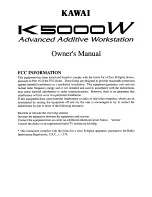
Amplifier Phase Shift Measurements:
In the square wave testing section of this manual,
square wave distortion is explained in terms of phase shift of
the signal components which comprise the square wave.
These phase shifts can be verified directly by providing a
s
\ne wave input signal to the amplifier and observing the
phase of output signal with respect to the input signal.
In all amplifiers, a phase shift is always associated with
a change in amplitude response. For example, at the — 3 d B
response point, a phase shift of 4 5 ° occurs. Fig. 11 il-
lustrates a method of determining amplifier phase shift
directly. In this case, the measurements are being made at
approximately 5000Hz. The input signal is used as a
reference and is applied to the CH1 input jack.
The V A R I A B L E control is adjusted as required to
provide a complete cycle of the input waveform displayed on
8 div horizontally, while the waveform height is set to 2 div.
The 8 div display represents 360° at the displayed frequen-
cy and are centimeter represents 4 5 ° of the waveform.
The vertical attenuator controls of CH2 are adjusted as
required to produce a peak-to-peak waveform of 2 div. The
CH2 POSITION control is then adjusted so that the CH2
waveform is displayed on the same horizontal axis as the
CH1 waveform. The distance between the two waveforms
then represents the phase shift between the two
waveforms. In this case, the zero crossover points of the
two waveforms are compared. The illustration shows a
phase difference of 1 div which means a phase shift of 45°.
A D J U S T A S R E Q U I R E D
FOR C O M P L E T E C Y C L E
IN
8cm
A F
S I G N A L
G E N E R A T O R
4r
I N P U T
A U D I O
A M P L I F I E R
O U T P U T
L O A D
Fig. 12. Measuring amplifier phase shift
Television Servicing:
Many television servicing procedures can be performed
using single-trace operation. These are outlined later in the
application section covering single-trace operation. One of
these procedures, viewing the multi-burst signal in the VITS
(vertical interval test signal), can be accomplished more
effectively using a dual-trace oscilloscope. The VITS signal
is specifically used for characteristic checks of the transmis-
sion system of a broadcast station or a network including
repeater stations or for changeover of transmission system.
In many cases, this signal does not appear in the normal
video signal. Even when it is included in the signal, the
method of inserting the information differs depending on the
broadcast station. Also, the VITS information in Field 1 (1st
interlaced scanning) and Field 2 (2nd interlaced scanning)
are different in many cases. Examples of VITS signals are
shown in Fig. 13.
Because the oscilloscope sweep is synchronized to the
vertical blanking signal, the waveform of Field 1 cannot be
distinguished from that of Field 2. This causes the VITS
signals to be superimposed onto each other, resulting in dif-
ficulty in viewing. With dual-trace operation using the same
input, the waveform can be viewed separately without
overlapping because of the effects of the oscilloscope's
alternate sweep operation and interlaced scanning of TV
signal.
The possibility of viewing VITS signal provides an im-
portant role in servicing TV sets. This VITS signals can
localize trouble in the antenna, tuner, IF or video sections
and shows when realignment may be required. The follow-
ing procedures show how to analyze and interprete os-
cilloscope displays of the VITS.
The VITS is transmitted during the vertical blanking in-
terval. On the television set, it can be seen as a bright white
line above the top of the picture, when the vertical linearity
or height is adjusted to view the vertical blanking interval (on
TV sets with internal retrace blanking circuits, the blanking
circuits must be disabled to see the VITS).
14
















































